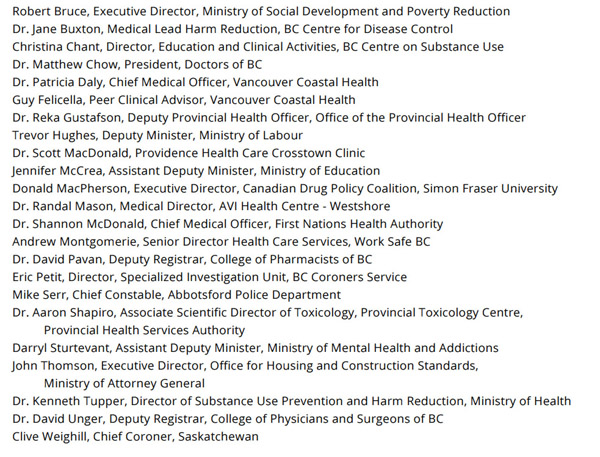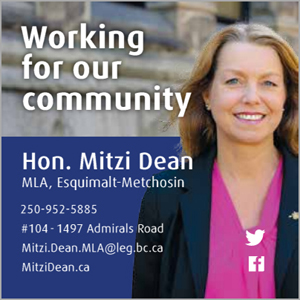
Wednesday March 9, 2022 | VICTORIA, BC
by Mary P Brooke | Island Social Trends
What’s been done in BC to date has not curtailed or reversed the extent of illicit drug use that has led to so many deaths since 2016. Much of the specific approach has been to make more treatment beds available, which is dealing with the end-point of the problem for those who have survived drug overdose.
There were 6,007 deaths from illicit drug toxicity over a four-year period (Aug. 1, 2017 to July 31, 2021) and 1,854 before that, said BC Chief Coroner Lisa Pointe today. More than 9,000 lives have been lost, she said.
In today’s Wednesday morning media session, Michael Eglison, death review panel chair, said that illicit drug overdose is the “leading cause of unnatural deaths” in BC. He itemized the drug-related death total is higher than all of suicides, homicides, motor vehicle incidents, drowning and fire combined.
Creativity and urgency required:
The over-arching theme launched by Lapointe and Eglison today can be summarized in two concepts: ‘think outside the box’ and ‘urgency’.
There was a bit of ‘COVID envy’… it was mentioned several times today that the remarkable level of urgency, adaptation, and funding devoted to dealing with the COVID health emergency should be matched in ways to deal with the drug overdose crisis. During the last two years of the COVID crisis that same messaging attempted to surface amid the din of the pandemic messaging.
Socioeconomic impacts:
Today as part of the release of recommendations from the BC Coroners Service Death Review Panel (in their report BC Coroners Service Death Review Panel: A Review of Illicit Drug Toxicity Deaths), Eglison said, absolutely, the social and economic exclusionary factors of society that underlies many of the reasons why people seek escape with drugs.
In some or many cases, use of drugs for leisure escape can lead to addiction.
Challenges with housing and income disparity are key stressors for people in communities across BC. Where there are no perceived alternatives, people can choose various means of escape, with drug use being one of them. While today’s session did not go anywhere near a discussion of a guaranteed livable income, that sort of approach to social support and cohesion would likely be helpful.
Attention by a spectrum of ministries required:
Part of the report does recommend that a wide spectrum of provincial ministries look at the problem through various lens.
“Health promotion is part of the continuum,” said Eglison today. He said that would be together with “intensive treatment”. To deal with the impacts of social exclusion, there needs to be involvement from the ministries of education, housing and mental health as well as community agencies, he outlined.
To date, most of the attention to the drug overdose health emergency in BC (officially declared by the Provincial Health Officer in 2016) has been handled through the Ministry of Mental Health and Addictions, first under then-Minister Judy Darcy (her background was nursing) and since 2020 under the direction of Minister Sheila Malcolmson (more of a social services model). Malcolmson is also a member of the Cabinet Committee on Social Initiatives.
The Ministry of Social Responsibility and Poverty Reduction is headed up by Minister Nicholas Simons; executive director of that ministry is Robert Bruce who participated in the Coroner’s death review panel.
Drug toxicity has increased:
“The current drug policy framework of prohibition is forcing substance users to access the unregulated market, leading to increased numbers of substance-related emergencies and deaths,” it was stated in today’s report.
The level of toxicity of illicit drugs has increased over the past several years — the data evidence is there, it was confirmed today.
Some recommendations in the report address grappling with the components of drug supply itself, including advising people about any presence or changes in certain components (such as fentanyl) or even that drugs can be checked for what they contain before a person uses them.
Average age 42:
The average age of persons who have died from illicit drug overdose in BC is 42 years. Almost 80 percent of the deaths are among men of young to middle-age, about 25 percent of which were working in the construction industry.
In January, BC Government funding of $1 million was issued to the Vancouver Island Construction Association for their coordination of a Tailgate Toolkit program was launched to help construction workers have access to information and supports.
West shore & Greater Victoria:
The number of overdose calls paramedics have responded to within the community in 2021 was 35,525 across BC. One might look at this with a lens of access to or the presence of socioeconomic stability through employment, community, family and overall societal views.
Of those, 155 were in the fast-growing city of Langford — up from each previous year (89 in 2016, 99 in 2017, 123 in 2018, 122 in 2019, and 123 in 2020). In largely suburban Colwood the overall level of usage is lower compared to the larger adjacent city of Langford, but in Colwood the number of calls nearly doubled in the same 2016 to 2021 time period (25, 27, 48, 38, 43, 46).
There was a steep trajectory in 2021 in the more rural area of Sooke (35, 42, 39, 36, 37, 62). Less steep than in Sooke, there was a similarly noticeable jump in View Royal last year: 37, 39, 38, 33, 28, 48.
In Victoria the stats show a steady increase, with a jump in 2021: 1,149, 1,398, 1,531, 1,412, 1,569, 1,952. In Saanich numbers were fairly consistent in 2016-2020 but took a jump in 2021: 251, 269, 265, 261, 265, 342.
Numbers were fairly steady in Esquimalt: 70, 83, 75, 77, 71, 75.
Panel profile:
Members of the panel were appointed by the chief coroner under Section 49 of the Coroners Act and included professionals with expertise in public health, health services, substance use and addiction, medicine, mental health, Indigenous health, education, income assistance, oversight and regulation, and policing.
Regardless of their employment or other affiliations, individual panel members were asked to exercise their mandate under the Coroners Act and express their personal knowledge and professional expertise.
Three recommendations:
The panel͛’s advice to the chief coroner includes three recommendations:
- Ensure a safer drug supply to those at risk of dying from the toxic illicit drug supply.
- Develop a 30/60/90-day Illicit Drug Toxicity Action Plan with ongoing monitoring.
- Establish an evidence-based continuum of care.
The chief coroner has forwarded each of the panel͛’s recommendations to the relevant ministries and organizations.
===== LINKS:
Death Review Panel Reports and Information (government website)
Overdose & Drug Poisoning Data (BC)
BC Coroners Service Death Review Panel: A Review of Illicit Drug Toxicity Deaths (PDF)
===== RELATED:
BC Coroners panel calls for safer drug supply, continuum of care (March 9, 2022)
Worker drug-poisoning prevention led by Vancouver Island construction industry (January 13, 2022)
VICA aims to lead economic recovery through institutional, commercial & industrial construction (December 3, 2021)
Boosting addictions recovery with more treatment & recovery beds (July 12, 2020)









